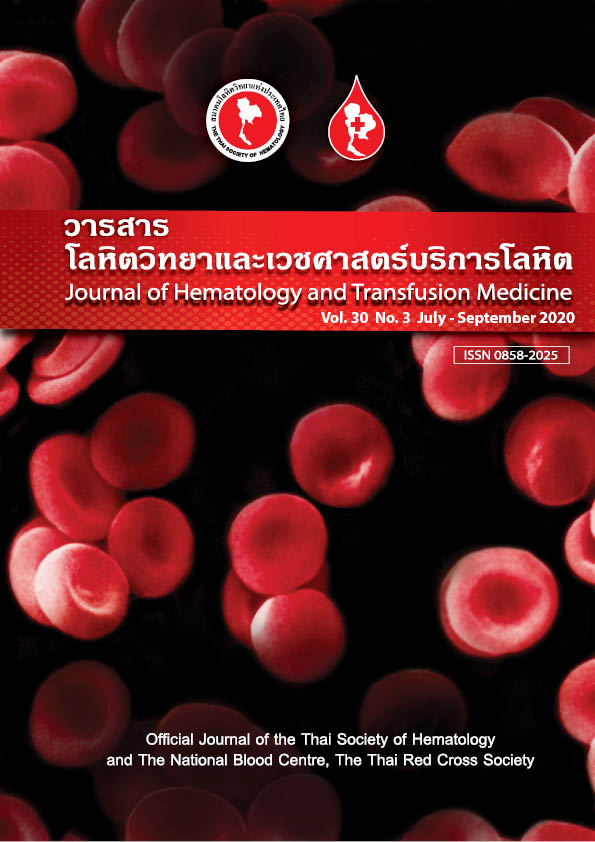Clinical outcomes of pediatric patients with severe idiopathic aplastic anemia in King Chulalongkorn Memorial Hospital
Keywords:
severe aplastic anemia, immunosuppressive therapy, Stem cell transplantationAbstract
Background: Idiopathic severe aplastic anemia (SAA) is a rare disorder among children. The modality of treatment is matched sibling, allogeneic stem cell transplantation or immunosuppressive among patients who do not have a matched donor as first line therapy. The responses to the treatment vary depending on the reports.
Objectives: The study aimed to evaluate the outcomes of children with idiopathic SAA in our institution.
Methods: A retrospective chart review included all patients aged 1 to 18 years, diagnosed with SAA between
June 1, 2004 and June 30, 2019, who had been treated at King Chulalongkorn Memorial Hospital.
Results: Thirty pediatric patients (22 males and eight females) median age 6.4 years were enrolled. Twenty-three patients (76%) received ATG plus cyclosporine, while 3 patients (10%) received androgen plus low dose prednisolone as a first treatment. Eight patients, (34.7%) receiving ATG plus cyclosporine, achieved a response at 3 months. Among unresponsive patients, 8 patients (53.3%) received androgen plus low dose prednisolone while the remaining 7 patients received 2nd ATG plus cyclosporine. Five-year overall survival was 72.9% (95%CI: 0.49 – 0.86) in the ATG plus cyclosporine group. Four patients underwent matched sibling, allogeneic stem cell transplantation while 3 patients survived without the disease. The 5-year overall survival of all patients was 69.4% (95%CI: 0.49 – 0.82), and the median follow-up totaled 4.3 years.
Conclusion: This study demonstrated that treatment of SAA using immunosuppressive therapy, consisting of ATG plus cyclosporine, had acceptable outcomes. Matched sibling, allogeneic stem cell transplantation is considered a first-line treatment with superior outcomes compared with immunosuppressive therapy. However, the limitation is donor availability.
Downloads
References
Marsh JC, Ball SE, Cavenagh J, Darbyshire P, Dokal I, Gordon-Smith EC, et al. Guidelines for the diagnosis and management of aplastic anaemia. Br J Haematol. 2009;147:43-70.
Young NS. Aplastic Anemia. N Engl J Med. 2018;379:1643-56.
Brodsky RA, Jones RJ. Aplastic anaemia. Lancet. 2005;365:1647-56
Rogers ZR, Nakano TA, Olson TS, Bertuch AA, Wang W, Gillio A, et al. Immunosuppressive therapy for pediatric aplastic anemia: a North American Pediatric Aplastic Anemia Consortium study. Haematologica. 2019;104:1974-83.
Garanito MP, Carneiro JDA, Filho VO, Scheinberg P. Outcome of children with severe acquired aplastic anemia treated with rabbit antithymocyte globulin and cyclosporine A. J Pediatr (Rio J). 2014;90:523-7.
Young NS, Calado RT, Scheinberg P. Current concepts in the pathophysiology and treatment of aplastic anemia. Blood. 2006;108:2509-19.
Scheinberg P, Wu CO, Nunez O, Young NS. Long-term outcome of pediatric patients with severe aplastic anemia treated with antithymocyte globulin and cyclosporine. J Pediatr. 2008;153:814-9.
Bacigalupo A, Brand R, Oneto R, Bruno B, Sodé G, Passweg J, et al. Treatment of acquired severe aplastic anemia: Bone marrow transplantation compared with immunosuppressive therapy-the European group for blood and marrow transplantation experience. Semin Hematol. 2000;37:69-80.
Bacigalupo A. How I treat acquired aplastic anemia. Blood. 2017;129:1428-36



